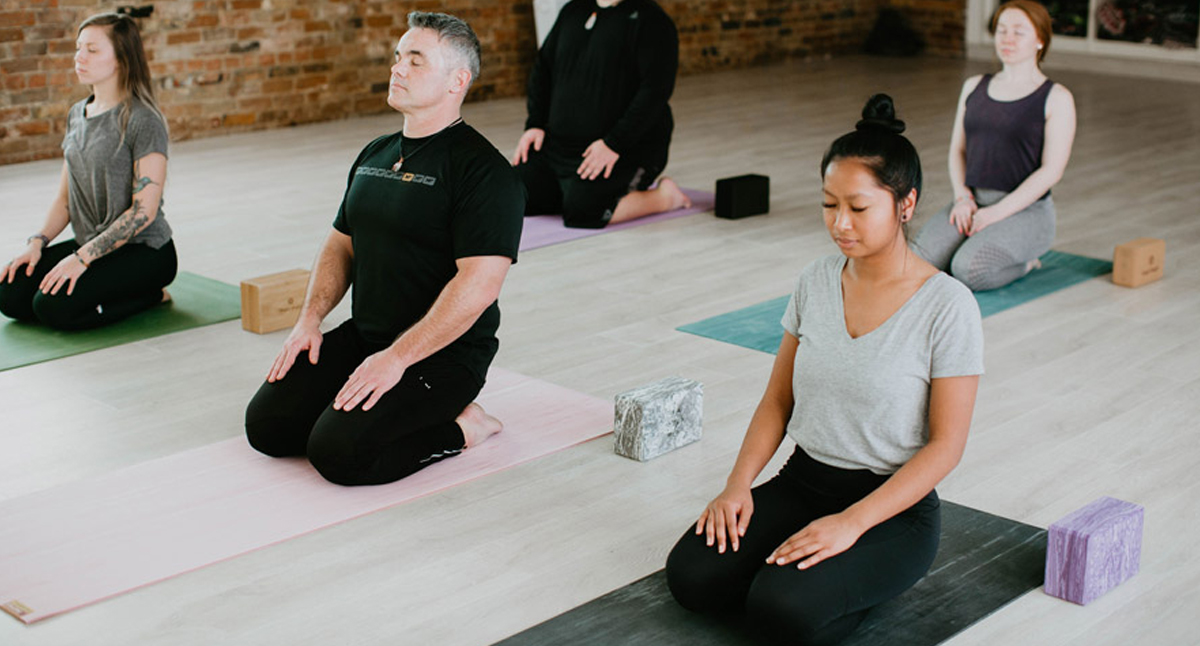This entry was posted on Apr 17, 2024 by Charlotte Bell.

If you practice yoga, you’ve probably heard the entreaty, “Listen to your body.” It’s good, sound advice. When you embark on any physical practice, it’s important to know and respect your body’s limits. Tuning in and listening to your body and what it’s trying to communicate to you each time you practice is essential not only to your body’s health, but to the growth of your practice. How else can you really know the effects of an asana?
As teachers, we can’t truly know what another person is feeling in his/her body. So encouraging students to develop their own body awareness is crucial. Although listening to your body, and encouraging your students to do so, is very important, sometimes it is not enough to keep your body safe.
3 Reasons Why Listening to Your Body Might Not Be Enough
Body Awareness Is Not a Given
Some of us come to practice with fairly refined body awareness, while others come to practice barely able to understand what they’re feeling even when it’s not at all subtle. This disparity might be the result of some people having already engaged in lots of physical activity while others have not. A person who has suffered physical or emotional trauma could be either hyper-aware of physical sensation, or might have developed a mechanism to shut down extreme sensation. Whatever the reason, it’s safe to assume that every student who comes to your yoga classes is not experiencing the same level of body awareness. So not every student will be able to trust his/her listening skills, at least at first. This is where an experienced teacher who knows how to assess alignment integrity is so important. And alignment integrity doesn’t look the same for every person—humans are not cookie cutters.
Ligament Pain May Not Show Up in the Moment
Even if your body awareness is very refined, there are times when you might be hurting yourself inadvertently. A pose may feel fine in the moment, but in some cases, the pain response could be delayed. For example, you may not feel overstretched ligaments until the next day. Once ligaments are overstretched, they don’t return to their original length. Over time, consistently over stretching ligaments can destabilize your joints. Refraining from pushing to your absolute edge is smart, healthy practice, for your ligaments as well as your cartilage (up next!).
Joint Damage is Often Hidden—Until it Isn’t
A stickier, more long-term issue is the possibility of joint damage, especially in the hip joints. Our acetabula (the sockets of the hip joints) are lined with a cartilaginous surface called the “labrum.” In addition, cartilage covers the heads of our femur bones. The cartilage on both surfaces allows the ball and socket to articulate smoothly and freely. Cartilage has no enervation, so we can’t feel the ball and socket articulating with each other. When we make a habit of pushing or collapsing into our joints—this especially applies to the bendier folks—the cartilage can tear or wear down over time. We don’t feel cartilage damage until the cartilage is gone, and then it’s often too late. Fortunately, hip replacement surgery has improved by leaps and bounds. But a better idea would be to avoid over stretching our joints in the first place.
How Can Yoga Teachers Help?
As teachers, we should encourage students to listen to their bodies, and help them understand that pain and discomfort are signals to back off, not to keep going. But we also need to train ourselves to know what collapsing into a joint looks like. Some of the poses that people commonly collapse or push into their hip joints include extreme hip openers—think Kapotasana (Pigeon), Hanumanasana (splits), Anjaneyasana (lunges) and Yoga Nidrasana (ankle behind the head). (Do you really need to put your ankle behind your head to enjoy a grace-filled life?)
Backbends can be a problem as well because there’s a tendency to push into your hip joints to get that extra few millimeters of height. And that ubiquitous instruction about keeping your pelvis squared in standing poses? Please don’t do it. Let the hip of your back leg rotate inward so that you maintain continuity between the legs and pelvis. This goes for twists as well.
Listening to your body is essential. You can avoid a lot of present and future suffering by simply paying attention. But also, do remember that just because everything feels fine in the moment, it may not be in the long run. Know what normal range of motion is for your joints. And remember: Nowhere in yoga’s texts does it say that pushing past your limits is good practice. Remember shtira (stability) and sukkha (ease) from Sutra 2.46? (Translated: The physical body should be steady and comfortable.) If you’re going to put energy into anything in your practice, aim for a balance between these two qualities. And find yourself an experienced teacher who knows what that means.
About Charlotte Bell
Charlotte Bell discovered yoga in 1982 and began teaching in 1986. Charlotte is the author of Mindful Yoga, Mindful Life: A Guide for Everyday Practice and Yoga for Meditators, both published by Rodmell Press. Her third book is titled Hip-Healthy Asana: The Yoga Practitioner’s Guide to Protecting the Hips and Avoiding SI Joint Pain (Shambhala Publications). She writes a monthly column for CATALYST Magazine and serves as editor for Yoga U Online. Charlotte is a founding board member for GreenTREE Yoga, a non-profit that brings yoga to underserved populations. A lifelong musician, Charlotte plays oboe and English horn in the Salt Lake Symphony and folk sextet Red Rock Rondo, whose DVD won two Emmy awards in 2010.

